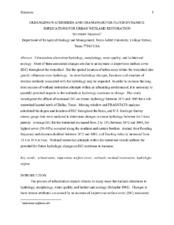| dc.description.abstract | Urbanization alters river hydrology, morphology, water quality, and habitat and ecology. Most of these associated changes are due to an increase in impervious surface cover (ISC) throughout the watershed. But the spatial location of urban areas within the watershed also greatly influences river hydrology. As river hydrology changes, functions and structure of riverine wetlands associated with the hydrology may be impacted. In order to increase the long-term success of wetland restoration attempts within an urbanizing environment, it is necessary to quantify potential impacts to the wetlands as hydrology continues to change. This study investigated the effects of increased ISC on stream hydrology between 1972 and 1995 for a sub-watershed located north of Dallas, Texas. Moving window and FRAGSTATS analyses calculated the degree and location of ISC throughout the basin, and U.S. Geologic Survey stream-gauge data were analyzed to determine changes in steam hydrology between the 2 time periods. Average ISC for the watershed increased from 2 to 11% between 1972 and 1995, but highest cover (50–80%) occurred along the southern and eastern borders. Annual river flooding frequency and duration doubled between 1972 and 1995, and flooding velocity increased from 31.4 to 35.4 m3/sec. Wetland restoration attempts within the watershed should address the potential for future hydrologic changes as ISC continues to increase. | en |


